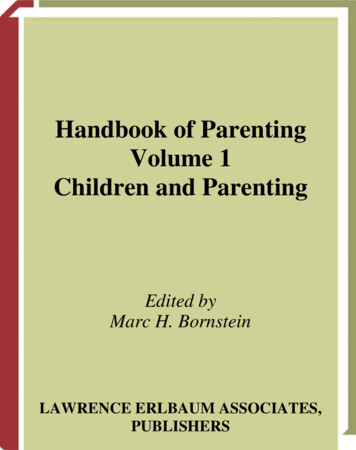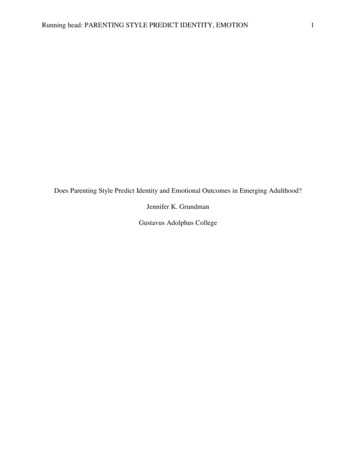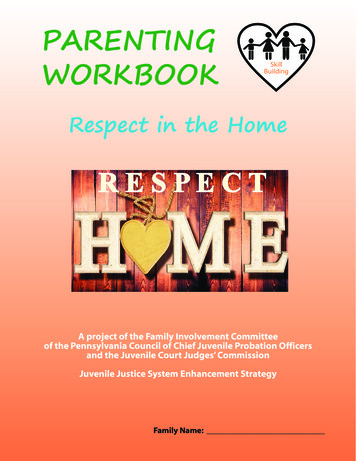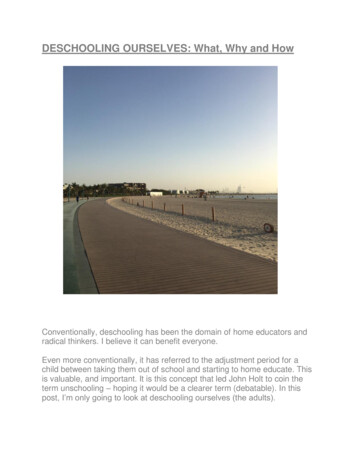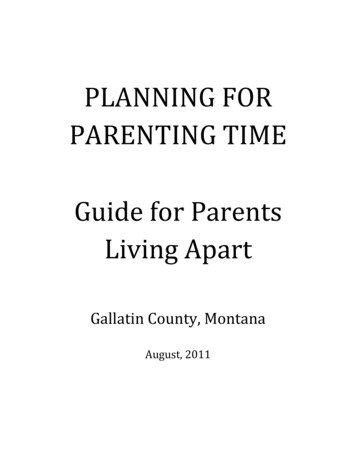
Transcription
PLANNING FORPARENTING TIMEGuide for ParentsLiving ApartGallatin County, MontanaAugust, 2011
IMPORTANT WARNING ON THIS GUIDE’S LIMITATIONSWARNING TO READERS: This guide does not give legal opinions or legal advice. This guideis not a substitute for the advice of licensed attorney. The guidelines present goodinformation on how to create a parenting plan that centers on the best needs of your child.The authors are not giving legal, accounting, or other professional services in this guide.The authors do not guarantee that the information in this guide is complete or accurate.They do not assume and specifically disclaim any liability to any person for any loss ordamage caused by errors, inaccuracies, or omissions that may appear in this guide.Laws and interpretations of laws change frequently, and the material contained in thisguide carries with it important legal consequences. Users of this material are solelyresponsible for determining the applicability of any information contained in this guide totheir situation and are strongly encouraged to seek professional legal and other expertassistance in resolving their parenting issues.This guide is based, primarily, on the Planning for Parenting Time: Arizona’s Guide forParents Living Apart. The Section on Safety Plans is based on the Oregon JudicialDepartment’s Safety Focused Parenting Plan Guide. They hold the copyright on theirmaterial, which are used with permission. It is also based upon discussion with family lawattorneys, local mediators, and child psychologists. The goal was to use a more “child‐centric” guide and apply to the unique problems Montanans face.This guide is not for amending or modifying an existing judge‐approved plan or de factoparenting plans. These suggested plans may be different than the judge‐approved plan youhave in place. These guidelines, by themselves, do not create changed circumstance for amodification of an existing parenting plan. That does not mean that you should not discussa more “child‐centric” plan with your client, attorney, or other parent. But you will need tomeet the same requirements to modify an existing plan. (See “Amending an Existing Plan”on page 68.)i
CONTENTSIMPORTANT WARNING ON THIS GUIDE’S LIMITATIONS . IUSING THIS GUIDE . 1TO PARENTS . 3WHY PARENTING PLANS ARE NECESSARY . 3HOW TO USE THIS GUIDE. 4DETERMINING THE BEST TYPE OF PARENTING PLAN: FLOW CHART . 5WHICH PLAN SHOULD WE CHOOSE? . 7IMPORTANT QUESTIONS TO CONSIDER WHEN CHOOSING A PLAN . 7CHILDREN BENEFIT WHEN PARENTS: . 8CHILDREN ARE HARMED WHEN PARENTS: . 8CHILD DEVELOPMENT. 9BIRTH TO 2 YEARS . 92 TO 3 YEARS . 113 TO 5 YEARS . 116 TO 9 YEARS . 1210 TO 12 YEARS . 13TEENAGERS (13 TO 18 YEARS) . 13SPECIAL MESSAGE FOR PARENTS AND MEDIATORS . 16FOR PARENTS. 16FOR MEDIATORS . 16SPECIAL MESSAGE ABOUT ATTORNEYS AND JUDGES . 18ABOUT ATTORNEYS . 18ABOUT JUDGES. 18PARENTING TIME SCHEDULES . 19SUMMARY OF PARENTING TIME SCHEDULES . 21PARENTING TIME EXAMPLES . 23PARENTING TIME SCHEDULE: PLANS 1, 2, AND 3 . 24PARENTING TIME SCHEDULE: PLANS 4 AND 5 . 25PARENTING TIME SCHEDULE: PLANS 6 AND 7 . 26PARENTING TIME SCHEDULE: PLANS 8 AND 9 . 27PARENTING TIME SCHEDULE: PLAN 10 (ALTERNATING WEEKENDS) . 29PARENTING TIME SCHEDULE: PLAN 11 (SPLIT WEEK) . 30PARENTING TIME SCHEDULE: PLAN 12 . 31ii
ContentsPARENTING TIME SCHEDULE: PLAN 13 (ALTERNATING WEEKS) . 32CHILD DEVELOPMENT AND SUGGESTED PARENTING PLANS . 33DESIGNING A PLAN FOR BIRTH TO 2 YEARS . 33DESIGNING A PLAN FOR 2 TO 3 YEARS . 34DESIGNING A PLAN FOR 3 TO 5 YEARS . 36DESIGNING A PLAN FOR 6 TO 9 YEARS . 40DESIGNING A PLAN FOR 10 TO 12 YEARS . 43DESIGNING A PLAN FOR TEENS . 47HOLIDAYS, VACATIONS, AND SCHOOL BREAKS . 51HOLIDAYS . 51VACATIONS . 52SCHOOL BREAKS . 53LONG–DISTANCE PARENTING AND RELOCATION . 55GENERAL RECOMMENDATIONS . 56AGE-SPECIFIC RECOMENDATIONS . 57BIRTH TO PRE-SCHOOL . 57KINDERGARTEN TO 12 YEARS . 5813 TO 15 YEARS . 5816 TO 18 YEARS . 58GENERAL TIPS . 59AIR TRAVEL. 59DELAYS AT EXCHANGE POINTS . 60DROP-IN VISITS. 60FREQUENT MOVES . 60INTERNATIONAL PARENTING TIME AND BORDER TRAVEL . 60MILESTONES AND CHILD DEVELOPMENT . 61TIME LOSS FOR TRAVEL . 61“VIRTUAL PARENTING”. 61WILD CARDS . 61SPECIAL ISSUES. 62ABSENT PARENT REUNIFICATION . 62BLENDED (STEP) FAMILIES . 62BREAST-FEEDING . 63CHILDREN WHO DON’T WANT TO SPEND TIME WITH A PARENT . 64CONTACT WITH AN INCARCERATED PARENT . 64iii
ContentsHIGH CONFLICT. 65MILITARY. 65NEVER MARRIED . 66SCHEDULES FOR FAMILIES WITH CHILDREN OF DIFFERENT AGES . 67SPECIAL NEEDS CHILDREN . 67THIRD-PARTY INVOLVEMENT. 67WHEN A PARENT CANNOT USE THEIR PARENTING TIME . 68SAFETY FOCUSED PARENTING PLANS . 69DO YOU NEED A SAFETY FOCUSED PARENTING PLAN?. 69DOMESTIC VIOLENCE . 69ALCOHOL OR DRUG USE OR ABUSE . 70PROTECTIVE ORDERS . 70SAFETY FOCUSED PARENTING PLAN OPTIONS . 70AMENDING AN EXISTING FINAL PARENTING PLAN . 71WHEN THE EXISTING FINAL PARENTING PLAN ISN’T WORKING ANY MORE . 71PROFESSIONAL SERVICES FOR PARENTS AND CHILDREN . 72ALTERNATIVE DISPUTE RESOLUTION (ADR): SOLVE IT WITHOUT A JUDGE . 72ASSESSMENT: PROVIDING INFORMATION TO THE JUDGE . 72THERAPEUTIC: GETTING HELP . 73OTHER . 74WORDS YOU MAY NEED TO KNOW. 75iv
USING THIS GUIDEThis guide is atool for you touse to design aparenting planthat will workbest for you andyour children.This guide for a parenting plan is intended to provide helpfulideas in making decisions about parenting time. A parentingplan is a document that states where the child will live, whenthe children will be with each parent, how much contact thechild will have with the other parent, and how major decisionswill be made. The plan is intended to protect the child’s bestinterest, to set out parental authority and responsibility, and tohelp prevent future court action.Coming to court can often feel frightening and confusing forparents and children. It is our hope that we can lessen yourconcerns by giving you basic information on how to develop aparenting plan. It is important that you take the opportunity toeducate yourself about what is expected of you.Continuing conflict between parents before, during, and afterdissolution will increase the stress and suffering of yourchildren. You should work out a parenting plan that gives themaximum meaningful contact and the minimum conflict.This guide provides sample plans for parents to use in reachingagreements or presenting proposals to the court. Attorneys,mental health professionals, mediators, and judges may alsofind the parenting time plans useful in resolving family courtdisputes.When you make a parenting plan, remember: You need to address all issues that affect parenting. You both need to define your role in your children’s lifeafter separation or dissolution. Parenting plans should be structured enough to beunderstandable and flexible enough to be realistic. A good parenting plan helps children. Children needconsistency, stability, and routine. The best agreement is reasonable parental contact uponreasonable notice. The next best arrangement is a detailed1
Using This Guideagreement that fits the needs of your children and for eachof the parents.Parents are encouraged to read this material and to getadditional information and advice in order to make the bestdecisions for their children. This guide will help parents reduceconflict and reach agreements more easily.Remember—This Guide: IS a tool for parents; IS NOT “the law”; DOES NOT prohibit or limit parents or judges from creatingparenting plans that differ from the sample plans presentedhere; DOES NOT mandate a minimum or maximum amount ofparenting time for either parent; DOES NOT mean that a judge will accept a proposed planthat is based on this guide; and MAY NOT be helpful in all circumstances.2
TO PARENTSRaising children presents challenges. When parents live in separatehomes, the challenges are greater because relationships are morecomplicated. Sometimes parents disagree about how much timechildren should spend with each parent.This guide is based on Planning for Parenting Time: Arizona’s Guidefor Parents Living Apart. It has been adapted for Montana law. TheSection on Safety Planning is based on Oregon’s Safety FocusedParenting Guide. This guide offers information about what a childlearns, feels, and needs at different ages. It also provides suggestedplans for each age group.In Montana, divorce is not a legal term. The term “divorce” is notused and has no legal meaning. Instead, the term dissolution ofmarriage is used.Unless special circumstances exist, preserving a healthy and ongoingrelationship between children and both parents after a dissolutionor separation is of greatest importance. Positive involvement withboth parents furthers the child's emotional and social development,academic achievement, and overall adjustment. Adult children ofdissolution describe the loss of contact with a parent and conflictbetween their parents as the most painful part of the dissolution orparental separation.WHY PARENTING PLANS ARE NECESSARYWritten parenting plans provide children and parents withpredictability and consistency and can prevent future conflict. Thisguide encourages open discussion and cooperation between parents.Courts prefer that parents reach agreements about parenting time.When parents reach agreements, they are more likely to cooperateas their children grow up. Children do best when their parentscooperate with each other. The reverse is also true. Children whoexperience ongoing conflict between parents are at high risk forsuffering serious long‐term emotional problems. If parents need helpto work out the schedules, court‐sponsored and private mediationservices are available. The Community Mediation Center ofBozeman Montana provides low‐cost mediation services for low‐income Montanans.3
To ParentsMontana does not use the words “custody” or “visitation.” Instead ituses the word “parenting” to promote the idea that both parentsshould be involved in the children’s lives.The key to successful co‐parenting is a written parenting plan thatstates the agreements parents reach about where the child will live,the sharing of rights and privileges, and the schedule for parentingtime.HOW TO USE THIS GUIDE Read the plans for your child’s age. Use the blank calendar on page 18 of this guide to mark the days and timeseach parent will have parenting time. This guide includes sample calendarswith sample language to include in court orders. These are examples only.You can choose any days or times you wish. Talk with the other parent about parenting time that meets yourfamily’s needs.Parenting plan forms are available at the Bozeman Self‐HelpCenter, and on the Internet at http://www.cmcmontana.org Programs- Family Mediation Forms. Fill out the form and file itwith the court.If you need help, contact the Bozeman Self‐Help Center at406-582-2158.4
To ParentsDETERMINING THE BEST TYPE OF PARENTING PLAN: FLOW CHARTQUICK VIEW FLOW CHART: WHAT TYPE OF PARENTING PLAN IS RIGHT?Follow the Flow Chart to determine the most appropriate Parenting Plan and special provisionsStart with the box below then follow the appropriate arrowsDo you and the other parent reside more than a regular commute apart?YESCheck Here if YesRefer to Page 55of the ParentingGuideNOHas the other parent:1. acted as though violent behavior against youor your child(ren) is alright?2. damaged or destroyed property during anargument?3. hurt a pet out of anger?4. been so sad or upset they could not care forthemselves or others?5. pushed, slapped, kicked, punched or hit youor the child(ren)?6. regularly abused and currently abusesalcohol or drugs?7. used weapons to threaten or hurt people?8. seriously threatened never to return thechild(ren)?9. threatened to kill you or the child(ren)?10. sexually abused anyone by force, threatof force or intimidation?11. been served with a protection or no contactorder from a Court?12. been arrested for harming or threatening toharm you or anyone else?13. engaged in other abusive or threateningbehavior?Include LongDistance ParentingPlan Provisions inYour Parenting PlanIf allanswersNOIf anyanswersYESProceed to Page 2Check Here if YesRefer to Page 69of the ParentingGuideInclude SafetyFocused Provisions inYour Parenting PlanAdapted from Bench Book Supplement by FL Association of Family and Conciliation Courts5Page 1
To ParentsQUICK VIEW FLOW CHART: WHAT TYPE OF PARENTING PLAN IS RIGHT?PAGE 2Continue from page 1& remember allchecked boxes1. I only communicate with my child(ren)’s otherparent by: using email; certified U.S. mail; a thirdparty (lawyer, relative, faith based professional etc.);our child(ren). (Please don’t answer yes if this iscaused solely by living far apart).2. I do not believe my child(ren)’s other parent is agood parent.If allanswersNODesign/Use a BasicParenting Plan3. I do not trust my child(ren)’s other parent toconsistently use good judgment and make gooddecisions regarding our child.4. I keep written and/or recorded records of allcontact between myself and my child(ren)’s otherparent.5. I feel it is okay to make all major decisions aboutmy child(ren) without consulting the other parent,because I have our child(ren)’s best interest at heart.6. My child(ren)’s other parent and I can onlyexchange our child(ren): in a public setting; with anadult third party present; with the police present; andor, by maintaining a safe physical distance.7. Because of my child(ren)’s other parent’s actions, Ihave serious concerns regarding our child(ren)’semotional and psychological functioning; peer orsocial relations; mother/child(ren) relationship;father/child(ren) relationship; school performance;behavior; and/or physical health.If anyanswersYESCheck Here if YesRefer to Page 65of the ParentingGuideIf you checked one ormore of the three boxesModify the BasicParenting Plan toinclude the necessaryprovisions for LONGDISTANCE, SAFETYFOCUSED, and/or HIGHLYSTRUCTURED DetailsInclude more detailand a high degree ofstructure in the PlanPage 1Adapted from Bench Book Supplement by FL Association of Family and Conciliation Courts6
WHICH PLAN SHOULD WE CHOOSE?The following parenting time options are designed to allow parentsor the judge, if necessary, to choose the proper plan after consideringthe family’s unique circumstances. Children differ in how long theyare comfortable being away from each parent. Some children likespending more time at one home, while others move between homeseasily. Parents may need to accept disruption of their own scheduleand spend more or less time with their children than they prefer sothey can give the children a sense of security and well‐being.When choosing a plan, parents should think about the child’srelationship with each parent. It may benefit the child to changefrom one plan to another as the child gets older. If a parent has neverbeen a part of a child's life or hasn’t had contact with the child for anextended period, parenting time should start slowly and graduallyincrease as the child adjusts and feels comfortable.If parents don’t agree on parenting time, the judge will listen to theevidence, evaluate the case, and order a plan the judge finds is in thechildren’s best interests. After a hearing, the judge may limit contactwith a parent if there is a finding that it would harm the child to havecontact with a parent.IMPORTANT QUESTIONS TO CONSIDER WHEN CHOOSING A PLAN How old is the child?How mature is the child?What is the child’s personality?How strong is the child’s attachment to each parent?Does the child or do the parents have any special needs, forexample, a child on the autism spectrum?What are the child’s relationships with siblings and friends?Are the parents’ homes too far apart to maintain regular andfrequent contact? (See page 52 on “Long‐Distance Parenting andRelocation.”)How flexible are the parents’ and child’s schedules?What childcare arrangements are needed?How and where will exchanges take place?How will transportation be provided?How well can the parents communicate and cooperate?7
Which Plan Should We Choose? What are the child's and the parents' cultural and religiouspractices?Are there any parental fitness concerns, such as domesticviolence, substance abuse, or mental health problems? If thereare, you may need a special safety focused parenting plan.What is each parent’s ability and availability to care for thechild’s needs?Will the parent be able to exercise the parenting timeconsistently? CHILDREN BENEFIT WHENPARENTS: Help the child have regular contact withthe other parent by phone, letter, audioand videotapes, e‐mail, and other forms ofcommunicationKeep predictable schedulesAre on time and have the child readywhen it’s time for the child to go with theother parentExchange the child without arguingSupport the child’s relationship with theother parentLet the child carry “important” items suchas favorite clothes, toys, and securityblankets with them between the parents'homesFollow similar routines for mealtime,bedtime, and homework timeHandle rules and discipline in similarwaysSupport contact with grandparents, step‐parents, and other extended family so thechild doesn’t lose these relationshipsAre flexible so the child can take part inspecial family celebrations and eventsGive as much advance notice as possibleto the other parent about specialoccasions or necessary changes to theschedule Provide the other parent with traveldates, destinations, and places where thechild and the parent can be reached whenon vacationEstablish workable and respectfulcommunication with the other parentPlan their vacations around the child’sregularly scheduled activities.CHILDREN ARE HARMED WHENPARENTS: 8Make their child choose between themQuestion their child about the otherparent's activities or relationshipsMake promises they don’t keepDrop in and out of the child’s lifeAre inconsistent in using their parentingtimeArgue with or put down the other parentin front of the child or where the childcan overhearDiscuss their personal problems with thechild or where the child can overhearUse the child as a messenger, spy, ormediatorStop or interfere with parenting timebecause child support hasn’t been paidDon’t show respect for each otherUndermine the child’s relationship withthe other parent.
Child DevelopmentCHILD DEVELOPMENTThese plans take into consideration different kinds of situationsbetween parents and children. The bond between a parent and childwill continue to grow as long as the parent remains actively involvedwith the child. However, some parents may not have had theopportunity to begin forming that bond. For example, when a planincludes overnights, it is expected that the parent with parentingtime has care‐giving experience and that the child is sufficientlybonded to and used to being in the care of that parent.If a child is not bonded to and not used to being in the care of one ofthe parents, it is important to start slowly. You may need to choose aplan that is simpler or has frequent shorter contact, to enable thechild to bond with the parent.BIRTH TO 2 YEARSBabies learn quickly. They are learning to love and trust familiarcaregivers. Babies become attached to parents and others throughconsistent, loving responses such as holding, playing, feeding,soothing, talking gently and lovingly, stimulating, creating bedtimeand bath time routines, and prompt attention to their needs. Babiesbegin to respond to a range of different (but equally valuable) typesof parenting styles that each parent provides.Most parents have different ways of parenting. It’s helpful if parentsshare information about how they’re parenting the child while thechild is in their care. In addition, parents need to be sensitive to theirbaby’s emotional reactions, ability to adjust to changes when goingfrom one parent to the other, and mood. It helps when parents talkabout these things when making or changing schedules.It’s important that they have frequent contact with each of theirparents and have a stable schedule and routine. On the other hand,babies do have “emotional
HOW TO USE THIS GUIDE Read the plans for your child’s age. Talk with the other parent about parenting time that meets your family’s needs. Use the blank calendar on page 18 of this guide to mark the days and times each parent will have parenting time. This guide includes sample c
